St. John’s high school students Kurtis Collins and Nora Boone, however, just want to help out in some small way to keep people healthy.
Collins, 16, a Grade 11 student at Waterford Valley High School in St. John’s, and Boone, 18, a Grade 12 student at Holy Heart of Mary High School in St. John’s, came second and third, respectively, in the recent Atlantic region edition of the Sanofi Biogenius Canada competition.
Speaking to Collins and Boone, you’d better be prepared to try to catch a few difficult-to-pronounce and hard-to-spell scientific terms … let alone understand their meaning.
According to a news release, Sanofi Biogenius Canada pairs exceptional young students with mentors to pursue real-world research projects.
Collins won the second-place prize of $1,500 for his science project that explores using flaxseed to protect the human colon from cancer cells. His mentor was Dr. Gary Paterno, associate dean of biomedical sciences at Memorial University.

“Colon cancer and many inflammatory-based diseases such as colitis, which in the colon are arising lately with cancer being very abundant, I decided to research what exactly causes these diseases and, as any biologist would know, there are thousands and millions of bacteria within your colon and they help to digest our food, but they constantly metabolize and produce these chemicals called free radicals,” Collins said. “Too much free radicals within your colon can lead to oxidative stress, and oxidative stress can cause mutation and in some cases that can start the development of cancer.”
Collins explained that antioxidants prevent the mutation from occurring, so he used a flaxseed extract compound called Secoisolariciresinol Diglucoside (SDG) in his research.
“SDG has already been proven to prevent any DNA damage within rat lung tissue from radiation,” he said. “In my study I developed an assay for evaluating the efficacy of SDG in colonic epithelial tissue, which is the lining of the colon. I wanted to do this to better represent a more human-based scenario.”
Collins said he was able to prove in his project that SDG can prevent mitochondrial DNA damage within colon cells when they are being damaged with free radicals.
“A diet enriched with flaxseed can compensate for oxidative stress and minimize the chance of cancer or any inflammatory-based diseases from occurring or arising,” he said.
Boone’s science project focused on using 3D printing to develop a simulation tool to train non-neurosurgeons to perform craniotomies for trauma. Her mentor was Dr. Roger Avery, and she did much of her project at the MUN Med 3D facility.
“In Newfoundland and Labrador we have really long transport times to a trauma centre — we only have one trauma centre, here in St. John’s — and that’s the only neurosurgical care unit, as well,” she said.
“Over 60 per cent of our population live outside a one-hour catchment to a trauma centre. If you compare that to say, Ontario, over 80 per cent of their population live within the one-hour catchment, so it’s a significant difference there.
“Basically, with head injuries requiring operative intervention the outcome is highly dependent on timely intervention, so generally the longer the wait time the worse the outcome.
“The procedure itself is kind of the two main components of it. You drill burr holes and you cut the bone between each burr hole and you kind of remove the bone flap, so then whether there’s a blood clot or just relieving pressure you can assess the situation from that point. The goal of this tool we developed would be to train those general surgeons living in the rural communities so patients don’t have to endure long travel times when it comes to severe head injuries.”
Both students say the experience of doing their project at MUN alongside world-class researchers was eye-opening.
“You only get to learn so much in high school courses,” Collins said. “This allowed me to learn exactly what research was like in the real world.”
Collins said he intends to pursue the field of medical research after high school and that his family is already very interested in his work.
“I now have them all on a flaxseed diet,” he said. “There’s a history of colon cancer in our family, so they are all interested in what I was doing.”
Boone also said she is considering going into medicine following graduation.
“To come third in such a competition is a good feeling,” she said. “I’m proud and very thankful to my mentor Dr. Avery and the MUN 3D med team because I really enjoyed working on this project all year,” she said.
“It was a great opportunity to go to such an event (Sanofi Biogenies) and a great learning experience, and to hear about what all the other students were doing was pretty amazing as well.”









